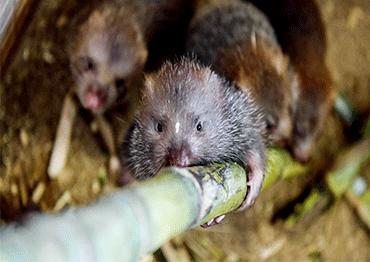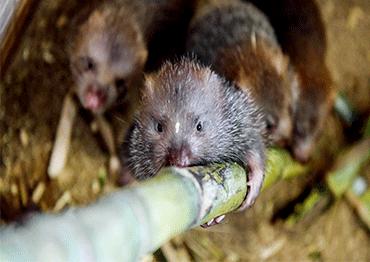There is a disinfection pool in front of Xie’s rat farm where workers wash their shoes before entering. Since the Covid-19 outbreak began, Xie said he has been disinfecting his farm at least once a week. “But many small rat farms never disinfect and everything goes well,” he said.
Liang Qiubo, head of Guilin Qiubo Bamboo Rat Company, said that raising rats is easier than raising poultry, pigs and sheep. “For example, poultry are susceptible to the bird flu, but bamboo rats are not prone to disease,” he told NewsChina.
China’s MARA has already released poultry farming standards that include facilities, disinfection and vaccines. “There are no national standards for raising bamboo rats,” said Xie, which he said is the biggest challenge for rat breeders. “Guangxi recently released local standards but they are not strictly implemented.”
According to an article by Peking University’s Shan Shui Conservation Center, during quarantines of livestock, third-party institutions inspect feed, the environment, facilities, workers and veterinary drugs to determine whether they pose any health risks. But inspections of wild animals are a greater challenge because it is difficult to determine exactly what they have eaten.
China’s Wildlife Protection Law divides wild animals into three categories: animals under State protection, animals under protection of local governments and animals with special economic, social or scientific significance. Bamboo rats belong to the last category. Before the ban on the consumption of wild animals on February 24, the Wildlife Protection Law had no prohibitive provisions on the consumption of bred bamboo rats.
According to Zhao Xiang, a professor with the Shan Shui Conservation Center, there are two prerequisites for wild animals to be on the white list: There must be a complete system for quarantine in place to guarantee public safety, and farmed animals will not negatively affect their species living in the wild.
Ma Yong, deputy secretary-general of the China Biodiversity Conservation and Green Development Foundation, argued that security and breeding technologies are crucial for bamboo rats to be on the white list. He told NewsChina that mass bamboo rat breeding has only been around for 30 years in China and there are few clinical studies on how it affects wild populations.
“From the perspective of public health, it is unlikely that quarantine standards on bamboo rats will be released soon,” he said.
Liu Yongfu, head of the State Council Leading Group Office of Poverty Alleviation and Development, said at a news conference in March that government agencies are working to distinguish which animals are safe to breed. Farms that are breeding animals on the banned list, he argued, would be shut down and compensated to change businesses.
Xie told NewsChina that if he were to take up pig farming, he would need at least 800,000 yuan (US$114,000) to start up his operation. “Coupled with the loans, I’d have to work for 16 years before I could turn a profit,” he said.

 Old Version
Old Version
